Menu

“The greatest threat to our planet is the belief that someone else will save it.” – Robert Swan
Regenerative agriculture marks a big change from old farming ways. These ways were harming our planet’s ability to bounce back. Now, in Europe and other places, farmers are learning new methods. These methods help the soil hold more carbon. This is crucial because farming, as we know it, is hurting the Earth. Each year, farming adds a lot of greenhouse gases to the air. It also wears away the top layer of soil. We only have so many harvests left before we must switch to better ways.
Dr Andy Zynga and leaders in the field, like PepsiCo and Greens of Soham, are at the forefront. They are showing that regenerative farming can not only save our soil but also secure our food future.
Conventional farming negatively impacts our planet in various ways. It causes a lot of greenhouse gas emissions. It also leads to the top layer of soil vanishing very quickly.
Using too many chemical fertilisers, growing just one crop in a field, and using too much water are big issues. They make it harder for different plants and animals to live together. Also, they make the soil wash away much faster.
Big farming that uses lots of technology is making these problems worse. They’re making the soil disappear quicker than it can renew itself. This kind of farming also makes chemicals flow into rivers and lakes, which hurts the animals and plants living there.
On the other hand, there’s an approach called regenerative agriculture. It works to heal the Earth. For example, in the Bay region, a plan is set to create large forest areas near rivers by 2025. This will take a lot of carbon out of the air every year.
Regenerative farming uses smart techniques like growing different crops together, moving animals between fields, and planting trees by rivers. These help protect the Earth. They also make the air and water cleaner.
People are now choosing food that’s kind to the environment. They want to know their food isn’t harming the planet. This has changed how food is grown.
Now, big companies are investing in farming that’s good for the Earth. PepsiCo, for example, is doing this. They’re working with farmers to grow food in ways that don’t damage the environment.
This shift is not just good for the planet. It’s also good for business. Investing in this kind of farming is expected to save a lot of money in the long run. It could return nearly 2 trillion dollars by not using as many chemicals.
Choosing to farm in ways that help the Earth is also smart for farming itself. It takes good care of our farms and helps crops grow better. This means we can keep farming for a long time without harming the Earth.
“Healthy soils, the foundation of regenerative agriculture, play a crucial role in enhancing biodiversity and ecosystem health, contributing to increased plant diversity and health above ground.”
Regenerative agriculture focuses on healthier ecosystems through smart farming. It uses soil health and organic practices for big benefits. This includes better environments and farming outcomes.
Building up soil health is key to regenerative agriculture. Important methods are less disturbing the soil and planting cover crops. In the UK, more than 70% of farm lands are for long-term grass. This offers a great chance for carbon sequestration. Increasing topsoil thickness means it holds more water. This helps plants grow better and supports fungi growth.
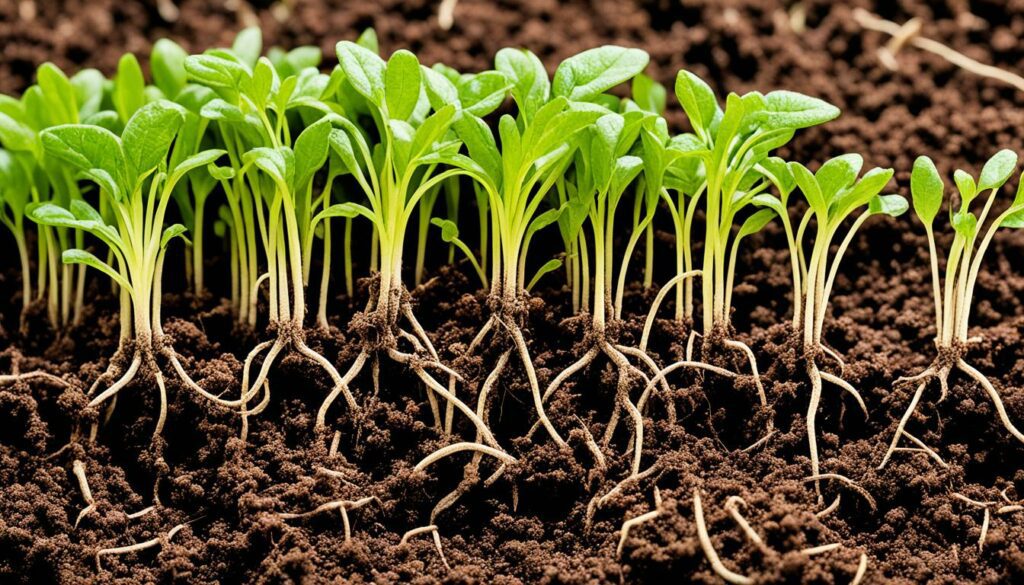
It’s vital to increase biodiversity through varied crops and their rotation. Not doing so has led to damaged soil and deserts, as seen in North Africa. Growing many plant types and keeping roots alive in the ground helps ecosystems. It also boosts farm productivity.
Good water management is crucial in regenerative farming. Using water wisely with proper irrigation means deeper root growth. This reduces water loss and helps prevent soil erosion and floods. It’s especially effective in overgrazed areas or those without enough ground cover.
Focusing on these areas – healthy soil, more biodiversity, and smarter water use – leads to a sustainable farm future. This is through using organic methods.
To embrace regenerative agriculture, we should use several approaches. These include cover cropping, rotational grazing, and keeping soil disturbance to a minimum. These steps are crucial for overall farm wellbeing. They, for example, improve soil health and help to cut pollution.
Using cover crops in the off-season is very important. It protects and enriches the soil. This method cuts nitrogen pollution in water by up to 60 percent. Also, every acre of cover crops helps store carbon and keeps soil healthy.
Rotational grazing means moving animals between fields. This is good for the land and stops overgrazing. When farms switch to this method, they release 42 percent less greenhouse gas. This also cuts pollution from nitrogen, phosphorus, and soil sediment.
Not digging up the soil keeps its structure and health. These practices also help trap carbon and stop soil from washing away. Today, avoiding deep ploughing is key to lasting farm productivity. It helps farms deal better with the changing climate.
| Practices | Benefits | Impact on Environment |
|---|---|---|
| Cover Cropping | Improves soil health, reduces nitrogen runoff | 60% reduction in nitrogen pollution |
| Rotational Grazing | Enhances soil regeneration, reduces overgrazing | 42% reduction in greenhouse gas emissions |
| Minimal Soil Disturbance | Maintains soil structure, supports carbon capture | Reduces soil erosion, improves microbial health |
Using these methods together is key to good farming. Cover cropping, rotational grazing, and careful soil work boost the farm’s strength. They also protect the environment more effectively.
Regenerative agriculture gives many pluses. It helps restore ecosystems, makes the climate tougher, and ensures there’s plenty of food. It cuts down on greenhouse gases by 42 percent, a big win for fighting climate change. It also lowers harmful runoffs by large amounts, making lands healthy again.
“The projected return on investment from regenerative agricultural practices stands at an impressive $1.9 trillion, arising from reduced reliance on synthetic fertilisers and pesticides.”
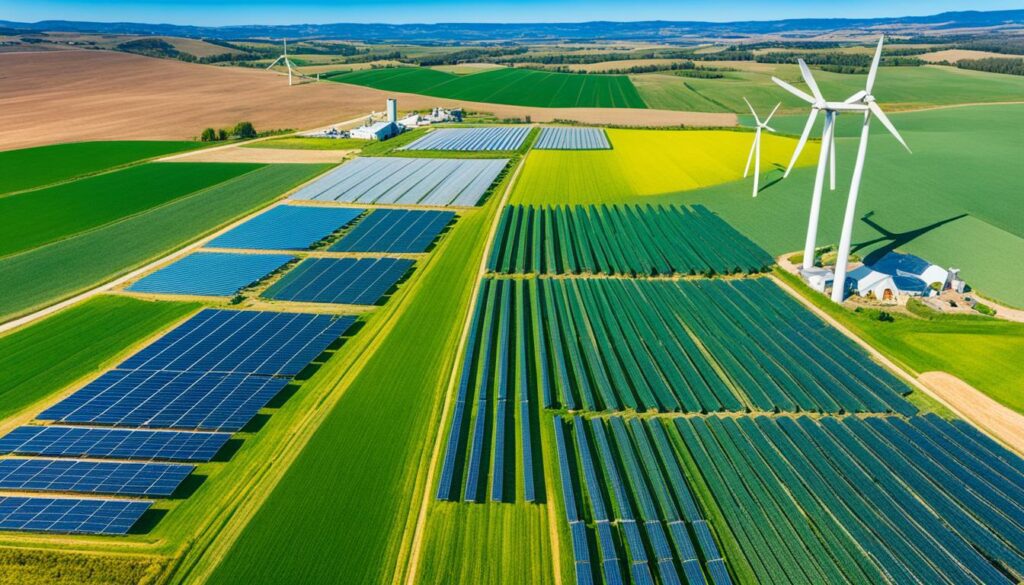
It stores over 173,000 metric tons of carbon dioxide each year. This is like taking more than 37,000 cars off the road. It makes our climate stronger and our food supplies safer. Growing food this way results in better crops and less need for harmful chemicals.
Farmers save money on things like feed and pesticides. This makes their farms more profitable. The way they use fertilisers and manure is better for the environment too, lowering harmful gas emissions.
| Benefit | Statistics |
|---|---|
| Reduction in greenhouse gas emissions | 42% |
| Decrease in nitrogen, phosphorus, and sediment runoff | 63%, 67%, 47% |
| Carbon dioxide sequestration | 173,000 metric tons annually |
| Projected return on investment | $1.9 trillion |
It also brings people together and offers learning chances. There’s more life on these farms, like more birds and bees. This makes the land richer.
Regenerative farming’s many benefits are key for a farming that can last. They highlight how important soil, life variety, and taking carbon are for food security.
Recently, there’s been a big focus on sustainable farming methods. People are looking more towards regenerative agriculture as an investment. This new way of thinking brings together modern tools and smart farming to gain both money and eco perks. Using tools that focus on precision, AI, and data leads to better farming outcomes.
Precision tools are key to making farming better by using less and wasting less. With the high-tech help of GPS and IoT, farmers can watch their crops, the soil, and even the weather. This not only cuts down on the need for pesticides by up to 100% but also helps manage resources smarter. This brings more money in and is kinder to the planet.
AI steps in to boost these precision gains by making smarter decisions. It looks into data and can predict how well crops might do or any upcoming troubles. For example, it helps to pick the best times to plant or harvest, meaning better crops. These tools also help cut down on things like fertilisers by half and pesticides by 75% for those who use them.
Having lots of data can smarten up how farming works in big ways. By looking at what works across many farms, we can learn to do better for the earth. It doesn’t just help with daily jobs but also with making the farm stronger for the future. Doing this change to smarter farming creates both short-term profits and big wins for the future. Things like soil getting healthier can really add up over time.
This move towards regenerative farming is really catching on with investors. They see a good chance to make money while doing something good for the planet. As we get better at using new technologies, farming’s future is starting to look greener and brings more profits all round.
| Benefit | Impact | Statistics |
|---|---|---|
| Reduction in Pesticide Use | Decreases by 50-100% | Regenerative farming can reduce pesticide usage significantly. |
| Increased Profitability | Up to 120% increase for wheat farmers in Kansas | $530.39 per hectare/year in profitability |
| Soil Carbon Stocks | Increase by 1-3 tons/ha/year | Improves soil health and contributes to climate resilience. |
Technology is changing how we farm in big ways. It’s key in moving towards practices that renew our land. With new tech, farmers can make crops better and keep our soil healthier.
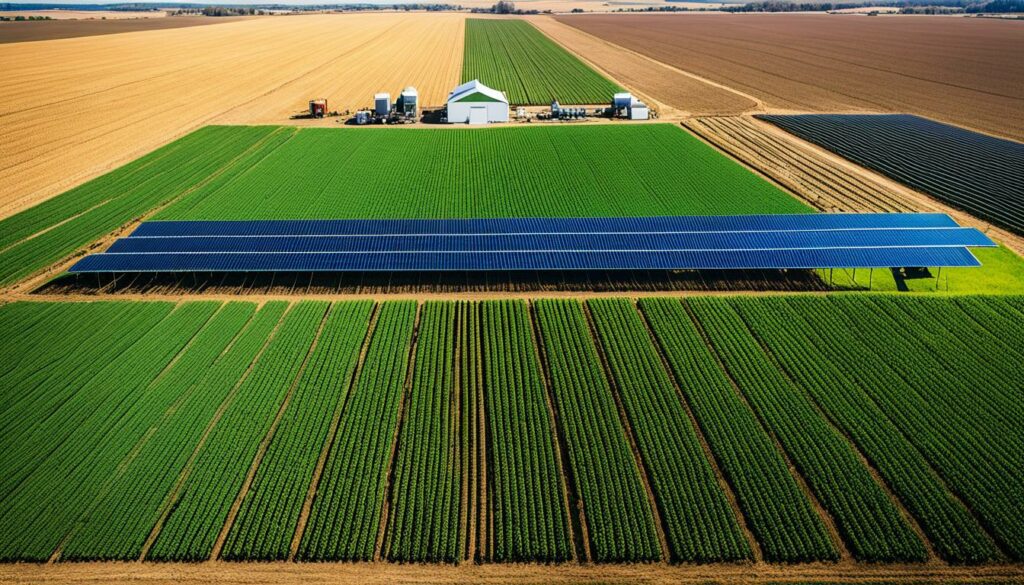
iCrop technology gives farmers real-time data on their crops and soil. This tech lets farmers act precisely, using less water, fertiliser, and pesticides. So, they can increase their harvests without harming the earth.
Agricultural sensors and farming apps are also making a big difference. They help farmers watch their farms closely and manage them precisely. For example, sensors improve how they water their crops. This saves water and helps the environment, while also boosting their profits.
Farmers are now using farming apps a lot. These apps give them loads of useful information. This helps in planning their work better. With these tools, tech for sustainable farming becomes more effective and farm-friendly.
So, technology is vital in sustainable farming. It includes iCrop technology, sensors, and farming apps. These tools help us face the issues of farming today and support nature’s renewal.
Holistic management is key in regenerative farming, helping soil health and growth. It uses methods like controlling pests without harmful chemicals. It also uses natural fertilizers. This way, the whole environment stays in balance.
The Certified Educator Training Program shows its success all over, from Texas to Australia. It’s for everyone, and many women, like Elizabeth Marks, are leading in this field.
This program is great for all kinds of careers. People from teaching, farming, science, and more join. They find it helps them make money smartly. For instance, Dick Richardson made back what he spent in just one year.
Phil Metzger found the program boosted his skills at work. It helped him work better with his team. This shows it’s not just about the earth. It’s also about making your work life better.
“The Certified Educator Training Program not only advanced my career but also significantly contributed to the adoption of holistic management practices in my community,” remarks Phil Metzger.
Studies show holistic management makes farms do better and earn more money. By looking at how everything is connected, we can solve more problems. This is a big change in how we care for our land and grow food.
| Aspect | Holistic Management | Mainstream Farming |
|---|---|---|
| Approach | Interconnected and Interdependent | Standalone Issues |
| Productivity Increase | Significant | Marginal |
| Profitability | Higher | Dependent on Synthetic Inputs |
| Soil Health | Promotes Regeneration | Often Erosion-Prone |
More farms around the world are choosing holistic management. This choice helps our soil and keeps farming strong. The approach of holistic management is complete. It helps us repair the land and build farms that can last.
Studying real-life examples of regenerative agriculture shows us the clear wins of sustainable farming. We will look at two top players in the field: PepsiCo and Greens of Soham.
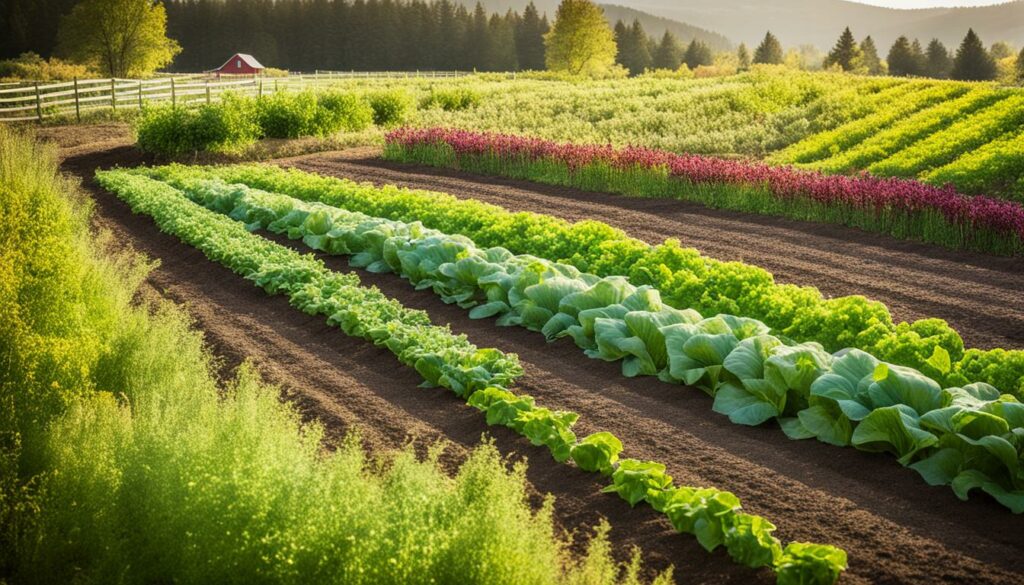
PepsiCo shows a strong dedication to being greener. It works with farmers everywhere to use regenerative practices in its supply chain. These steps aim to cut down a lot on greenhouse gas emissions.
The company also uses cool technology like iCrop. This tool helps improve how water, soil health, and crop growth work together. Such methods make PepsiCo’s global farming more tough and sustainable.
Greens of Soham stands out for its regenerative farming practices. By using these methods, the farm boosts its soil and can catch 6 tons of carbon per hectare every year. This shows that regenerative farming is not just good for nature. It also brings in new profits through carbon capture.
This farm’s success story proves that choosing regenerative farming pays off in the long run. It benefits the earth and the farming world too.
Regenerative agriculture’s growth owes much to public-private partnerships. They solve big sustainability challenges by combining government, non-profits, and businesses. These groups share resources and know-how for everyone to use sustainable methods.
Capital providers are key for regenerative agriculture to evolve. The sector has seen £2.61 billion in funds over 159 companies in the last half-decade. These partnerships pull together money from public and private sectors.
They make investments in climate-friendly farming, organics, and helping small farmers. This push means more people can practice regenerative farming.
Public-private partnerships offer more than money. They spark innovation and research by uniting governments, schools, and businesses. This togetherness leads to new gadgets like smart farming tools and eco-friendly farming techniques.
There’s been a steady 2.31% rise in regenerative farming deals. Such partnerships also improve talks between leaders, industry folk, and the public. This helps create smart, sustainable policies.
| Collaboration | Impact |
|---|---|
| Government Agencies | Policy development and funding support |
| Non-Profit Organizations | Advocacy and community engagement |
| Private Companies | Innovations in agricultural technology |
| Academic Institutions | Research and development of sustainable practices |
The partnership between Iowa State University and Deere & Company shows what these collaborations can do. They’ve created a research hub and a big demo farm. Their work highlights the major changes such teamwork can bring.
By pushing for these joint efforts, we aim to improve regenerative agriculture. This way, we help ensure that our food systems stay healthy for all.
Switching to regenerative agriculture faces many hurdles. Farmers, especially those sticking to old ways, worry about money and getting good harvests. It’s not easy to show them the lasting benefits of regenerative farming. But, we can work together to tackle these challenges.
Facing costs is a big issue in regenerative agriculture. Turning to this method can be expensive, especially for small farms. They need new tools, seeds, and cover crops that cost a lot. This money might not be easy to find quickly.
Getting the right balance for good harvests is hard too. At first, farmers might see their harvests drop. This happens as the land gets used to new ways. The unsure promise of making money fast back can be a big turnoff.
| Financial Challenges | Yield Optimisation Issues |
|---|---|
| High initial investment in equipment and seeds | Potential short-term decrease in crop yields |
| Accessing organic soil amendments | Uncertain yield stability during transition |
Getting farmers on board with regenerative farming is tough but crucial. Many are wary of the unknown and scared to leave their usual ways. They need a strong support system to trust these new methods.
Setting up sharing between farmers can help a lot. This way, they can see real benefits and support each other. Also, getting help with money, like grants or loans, makes it easier. And working with local sellers helps create more demand for regenerative goods.
“Financial constraints and yield uncertainty are formidable barriers, but with adequate support and knowledge transfer, we can overcome them together.”
Dealing with regenerative agriculture challenges, making farmers keen, and aiming for good harvests are key. Teaching, funding, and building strong local networks will lead to a bright, sustainable farming future.
The future of farming is at a turning point. There’s a big focus on increasing production while cutting down harm to the planet. These goals are key as we face more people and changing climates. So, it’s vital to find smarter and greener ways to farm.

Over the next decade, expect a strong move towards regenerative farming. This approach looks to heal the land and fight climate change. It fixes soil, making it healthier and more able to grow food. This means better quality crops and more sustainable farming.
This push for healthier soil also means better food for us and the environment. There will be more nutrients in our food, thanks to this sustainable style of farming. Plus, it lines up with the basic idea of caring for the land while growing crops.
Heading towards a sustainable future needs the support of big policy changes. For example, the EU’s farming policy aims to help farmers switch to greener methods. Also, working together across public and private sectors is crucial. It ensures farmers have the help and resources they need to change their ways. Companies like Greener Pastures and Pederson’s Farms prove that mixing good farming practices with the right policies reduces harm and offers healthier foods.
The right policies also need to follow what the markets want. They should spark more investments in greener farming and technology. The market for this kind of farming is set to grow a lot by 2030. This shows how important it is to keep coming up with new ideas and to support them financially. Good policies and healthy market interest will make sure regenerative farming’s methods spread far and wide.
| Company | Product | Method |
|---|---|---|
| Greener Pastures | Organic Chicken | Regenerative Farming |
| Pederson’s Farms | Organic Grass-Fed Beef | Regenerative Agriculture |
| Big Bluff Ranch | Organic Chicken | Regenerative Practices |
Regenerative agriculture is key in fighting climate change. It uses methods to both fight and deal with climate issues. This creates farms that can endure tough environmental conditions.
Farming globally causes a big chunk of greenhouse gases. Regenerative agriculture helps by absorbing carbon with techniques like using cover crops. This significantly cuts down on the carbon farming emits.
Methods like these not only fight climate change. They also make the soil healthier and increase plant and animal variety.
Using regenerative agriculture can make our environment more resilient. For example, farming shellfish and not ploughing too much can stop the ground from washing away. This helps farms deal better with bad weather, keeping our food supplies steady.
Also, mixing ancient indigenous wisdom with new tech brings more effective ways to adapt. This benefits the environment and keeps our food system strong.
| Strategy | Impact | Examples |
|---|---|---|
| Carbon Sequestration | Reduces greenhouse gases | Cover crops, agroforestry |
| Soil Health Improvement | Prevents soil erosion, improves crop yields | Minimal tillage, organic inputs |
| Water Management | Enhances water retention and quality | Efficient irrigation, shellfish farming |
Using these farming methods can really lessen climate change’s bad effects. It also keeps our farms working well. Regenerative agriculture is not just a way to fight today’s climate problems. It’s a plan for a strong future.
Getting enough healthy food worldwide is a big challenge. Using regenerative farming methods helps a lot. Not only does it improve the soil, but it also means we get more types of healthy food. This is very important because many go without food or have to eat poor-quality food.
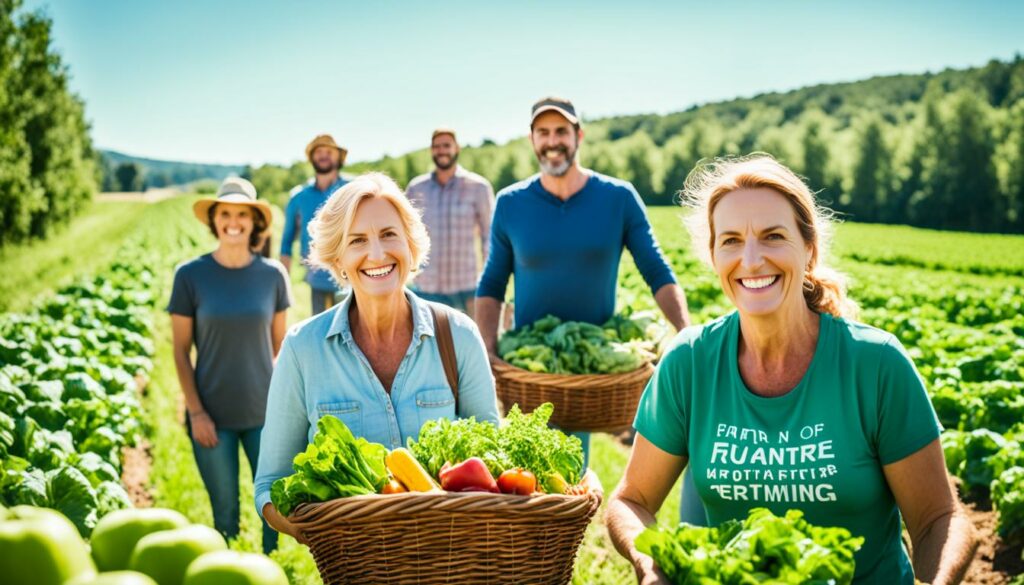
Over the years, the variety of vegetable seeds has dropped a lot—down by 94%. This has pushed the need for new farming ideas. Thankfully, regenerative methods can help. They make the soil better, which lets us grow more food that’s full of nutrients. Adding natural silicate rocks to the soil can boost its health. This results in more food and better quality.
Not everyone in the world gets food that’s good for them. This is a big worry. But regenerative farming can change that. By helping the soil to heal, we produce food that’s much more nutritious. This kind of food is key to fighting hunger and insecurity. Plus, cutting waste in food-making and buying steps can really help. It means more good food can reach those who need it most.
| Issue | Current Statistics | Regenerative Impact |
|---|---|---|
| Food Production Capacity | Feeds 10 billion people | Enhanced productivity with soil health |
| Food Waste | 40% wasted | Optimisation reduces waste |
| Seed Variety Loss | 94% of vegetable seeds lost | Increased biodiversity through heirloom seeds |
| Soil Degradation | 24% of global soils degraded | Restoration of soil productivity |
Europe and the United States show us exciting examples of *European regenerative agriculture* and *US agricultural innovations*. These examples highlight the power of sustainable farming. They also show us ways to improve farming sustainability around the world.
In Europe, farms are using *European regenerative agriculture* in creative ways. One example is turning potato peelings into organic fertiliser. This method makes the soil richer and cuts down on waste. It means healthier soil and less need for chemical fertilisers.
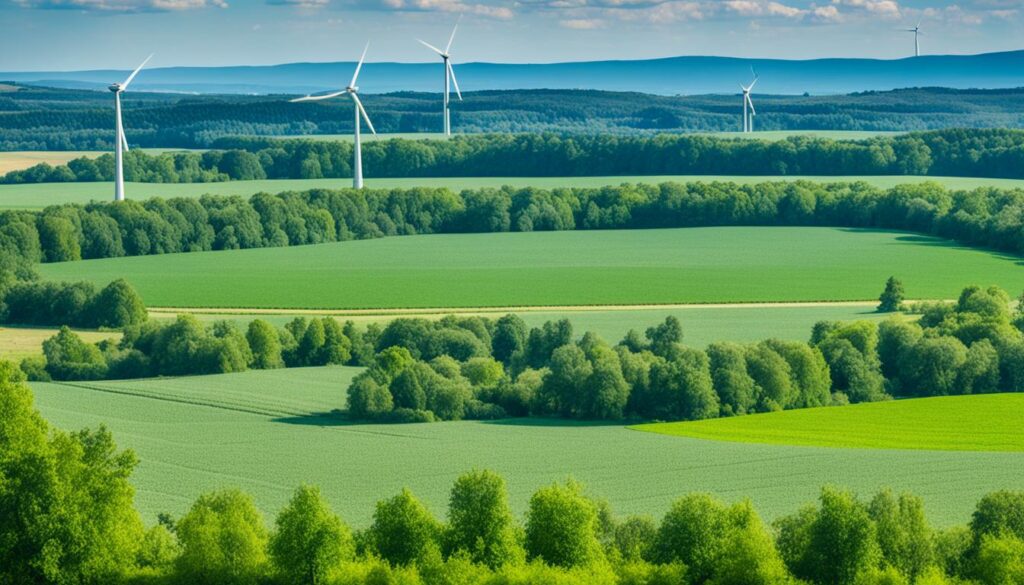
Precision agriculture is also crucial for sustainable farming. Farms are using high-tech tools to watch crops and soil closely. This helps them save water and fertilisers. Using these techniques helps the environment and makes farms more productive.
In the United States, there’s the impactful *1000 Farms Initiative*. It looks at *regenerative agriculture* on over 1,000 farms. These farms range in size and style. The main aim is to check the benefits of certain farming methods.
The 1000 Farms Initiative has shown big wins for the environment and farm profits. For example, some farmers have better soil and more plants, with less harmful chemicals. And, farmers like Laureano are producing three times more food.
| Aspect | European Example | US Example |
|---|---|---|
| Soil Health | Potato peel fertiliser | 1000 Farms Initiative |
| Technology Integration | Precision agriculture tools | Advanced data collection |
| Farm Diversity | Various crop rotations | Inclusion of women and Indigenous-led farms |
| Yield Improvement | Increased soil nutrients | Tripling of yields (e.g., Laureano) |
Through these studies from the US and Europe, we see how new farming ways can make a big difference. By blending permaculture, organic methods, and technology, we’re close to a better farming future. This future can be strong and successful everywhere.
The future of farming is in regenerative agriculture. This approach can help fight the big greenhouse gas challenge the world faces. It is key to keep global warming under 2°C. According to the World Bank and the UN, if we use 22 key strategies, we can reduce emissions. This will also make sure there is enough food for 10 billion people.
No-till farming, cover crops, and changing the crops grown are some of the ideas. Each has its own benefits. No-till farming stops soil from being washed away and lets water soak in better. Cover crops help keep water cleaner and take in a lot of carbon dioxide. They could trap around 100 million tonnes of carbon yearly. This is if 85% of U.S. farmland uses them. But, right now, just a few farms do this. So, more farms need to start to make a big difference.
The 6-3-4™ Standard framework gives great advice for farmers. It talks about 6 principles, 3 rules, and 4 things nature does well. These include looking at the local situation, sowing different crops, and keeping the soil covered. They also involve having plants in the ground all year and adding animals to the farms. If we follow these ideas, we’ll make the land and nature stronger. This will help us handle the effects of climate change. So, by making these changes now, we’re working towards a better future for farming.
Regenerative agriculture is a way of farming that helps the environment. It aims to make the soil better, increase plant and animal variety, and use water and carbon well. This kind of farming is unlike the usual way, as it cares more about the planet’s health in the long run.
Regular farming hurts the Earth by releasing a lot of bad gases, making the soil worse, and reducing different plants and animals. This new farming approach tackles these problems directly. It works on keeping the soil healthy, capturing harmful carbon, and helping our lands and waters bounce back – all to deal with the changing climate better.
The main ideas behind this type of farming are to make the soil healthier using natural methods, to help many kinds of plants and animals thrive, and to use water wisely. It also involves managing everything on the farm together. These things are all about making sure farming helps the environment more than it harms it.
In this approach, using certain methods is key. These include planting different crops at different times, letting animals graze in a way that helps the land, and moving the soil as little as possible. Also, it means looking at the whole farm as one system. These ways protect the soil, make sure many plants and animals can live there, and use natural resources well.
Choosing this kind of farming makes the land better, makes it easier for farms to deal with weather changes, and ensures there is good food for everyone. It also means more plants and animals can live in these spaces. These things add up to a healthier planet and a more secure food future for us all.
New tools and smart systems help farmers work in ways that are good for the Earth. For instance, iCrop and sensors let farmers watch how their crops and soil are doing all the time. With this information, farmers can make changes that keep the soil and plants healthy, using less water and energy.
Switching to this farming style can be hard at first, and some may worry about making less money. Helping farmers see the long-term benefits is important. Also, they need the support of many different groups, like other farmers, companies, and the government. This team effort is crucial for success.
By improving the health of the soil and growing a wider range of crops, this farming approach ensures there’s plenty of good food for all. This way, more people can count on always having healthy food to eat, without hurting the Earth.
These partnerships are important for getting more farmers to use regenerative methods. By working together, they share knowledge and provide the support farmers need. This teamwork between companies, governments, and others drives big positive changes in how we farm.